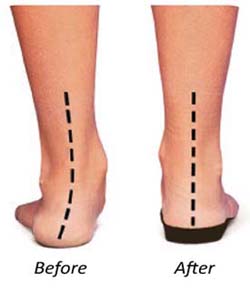How Orthotics Relieve Foot Pain
Feet are called upon to act as both shock absorbers and primary support for the human frame. These two diverse and demanding tasks are sometimes limited by natural quirks in our foot mechanics, or by chronic health conditions, such as arthritis and diabetes. Custom-made orthotics are designed to work primarily in two ways:
- The redistribution of weight bearing forces
- The control of abnormal foot conditions
Foot orthotics work by spreading the load taken by the heel and forefoot over a greater area of the foot. In this way, the amount of force in any one area can be reduced, resulting in a more even distribution of weight over the foot as a whole. Similarly, by creating soft relief areas, weight can be transferred away from painful locations—such as the metatarsal heads, heel spurs, or ulcers—thus minimising the discomfort caused by these conditions.
Foot orthotics can also be very effective in controlling abnormal foot conditions. This is achieved by designing orthotics that provide adequate support to the structures of the foot, or that work by applying appropriate corrective forces where needed. Control of the foot to counter abnormal foot conditions is very important, as poor foot alignment can result in secondary injuries to the ankle, knee, hip and spine.
Once a foot condition has been diagnosed and biomechanical assessment undertaken, a custom orthotic is designed and hand-crafted from a range of materials including soft, semi-rigid and rigid foam. These materials are blended to offer both comfort and support, combining to provide the balance of shock absorption and strength necessary to aid foot mechanics.
In certain circumstances, Kenny Orthotics offers the option to have a set of trial orthotics constructed. This enables the client to more effectively evaluate the benefit, before committing to the cost of full orthotics.


